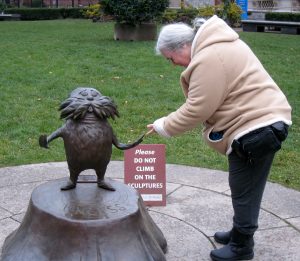Linda Thompson is a philologist and longtime Executive Assistant of the National Museum of Language. In fact, we like to think she’s the “glue” that holds the Museum in place. Lately, she has also been the cartoonist for the Greek language Philogelos and Arthur the Rat/Dictionary of American English (DARE) comic strips on our homepage.
Here is our interview with Linda, conducted by NML vice president Greg Nedved.

What is your language background?
My first real exposure to foreign languages began via two books in particular: a non-fiction compendium of information for children on world languages and cultures (I think it may have been called something like The Children’s Book of Knowledge), and a marvelous little illustrated children’s book titled Il y a Un Dragon dans Mon Lit (There is a Dragon in My Bed), which uses the frame story of two children taking a trip on an ocean liner to France in order to teach readers how to say various things in French – a kind of kid’s version of a travel guide phrase book.
In high school I took four years of Latin and two of Spanish. I continued to study both Latin and Spanish in college, and added ancient Greek and Old English (a.k.a. Anglo-Saxon) to my acquired languages collection; I graduated with a major in Classics (the study of Greek and Latin languages and cultures). I proceeded to pursue a master’s degree in Classics with a minor concentration in Old and Middle English, a semester’s concentrated exposure to Italian, and independent study in German by trading tutoring with a grad student from the German Department. Trips abroad later in life served as impetus for acquiring some basic level exposure to Dutch and Modern Greek.
How did you develop your drawing skills?
This happened the way that I acquired my exposure to German, Dutch, and Modern Greek. I’m what’s known as essentially a self-taught artist; i.e., not much formal training beyond that given in a public school education. I always feel that I have to qualify the “self-taught” description, because I consider my art teachers to have been all the other artists whose work I was exposed to via books: the artists who were featured in the instructional art books that my parents gave me, the illustrators of whatever children’s books I had, and all the innumerable comic book artists I imitated. For the purposes of comic art, the best “teachers” I’ve had have been artists such as Andrew Loomis, Jack Hamm, and Norman Rockwell.
Where would you like the NML to be in the next 10 years?
Back in an affordable actual real-life site somewhere accessible to the public, with funding to maintain our existence there. Ever since the NML closed its exhibit rooms, I’ve encountered a number of people who have said that they’d heard of the museum and had wanted to visit, but never had the chance. We still receive inquiries via our website from people who want to come for a visit, and we have to explain to them that we don’t have a physical location at present.
What have you learned from your experience with the NML?
Practical learning: what is involved in running a museum: setting up exhibits; publicizing exhibits; gaining funding; organizing and holding public outreach events; and more.
As far as the more esoteric learning I have acquired from working with the NML, see the next question.
Why does America need a National Museum of Language?
In a sense, this answer should also be part of my response to the previous question, because one of the most surprising things I learned from my experience with the NML is just how interested people are in language, languages, and culture. I think that provides at least one answer to this question – there is a need for this type of museum because the interest in such a museum clearly exists. Museums serve several important functions: via their exhibits and programs, they can preserve pieces of the past, examine aspects of the present, and speculate about the future. These functions are as pertinent to the study of language and languages as they are to any other discipline.
